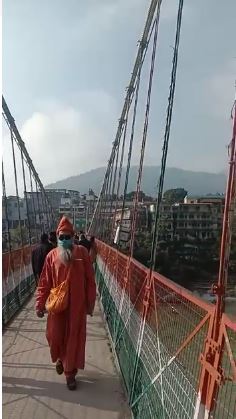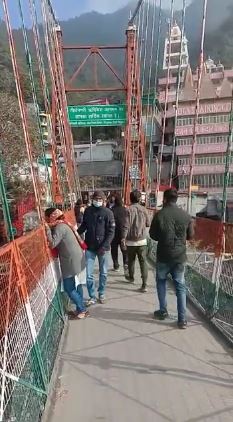
Syed Khalique Ahmed
NEW DELHI—On January 15, I visited Rishikesh, a Hindu religious town 35 km from Haridwar in Uttarakhand. Rishikesh, considered the abode of Hindu ‘rishis’ and sages, is the gateway to four Hindu Dhams – Badrinath, Kedarnath, Gangotri, and Yamunotri – in the Himalayas. The rivers Ganges passes by this town and flows downstream to Haridwar.
My former colleague Vikram Rautela, a native of Uttarakhand, had suggested I visit Rishikesh. Though he told me there are only temples in the town, I should see the natural beauty of the city and the areas along the road from Dehradun to this temple town. So, I accepted his advice and went to the city with my wife.

When my taxi driver halted the car in the parking area, a middle-aged person approached me, identifying himself as a tourist guide. He said he would charge Rs. 450 and would take me around different temples on the two sides of the river.
Before he could speak anything more, I told him that we are Muslims and are not interested in seeing temples. “Tell me what is there for Muslims to see in this temple town?,” I threw a question at him.
A few weeks ago, some controversial Hindu religious leaders had indulged into hate speeches against Muslims at Haridwar. Though making hate speeches has become a new normal for Hindu right groups across India, the extremists at Haridwar gave a call for genocide against Muslims and also appealed to the police and armed forces to participate in physical “cleansing” of Muslims. I wanted to see the impact of the appeal on people in this spiritual town, so I revealed my religious identity.

The guide was very frank and straightforward. In an amicable manner, he said that there is nothing for you as a Muslim in this town except two “jhulas” – Ram Jhula and Laxman Jhula – that are steel suspension bridges. UP Bridge Corporation constructed these for pilgrims to walk on either side of the river Ganges when Uttarakhand was a part of Uttar Pradesh. The guide said these are the only sights for you and your family, and you don’t require any assistance for this. He also showed the direction towards the suspension bridges. I did not see any hate or disliking for me and my wife in his language. No streak of hatred was discernible from his body language.
We went to the Laxman ‘jhula’, walked over it, along with other visitors. What was revealing is that all the Hindu visitors were young couples in Western dresses. We did not come across a single young couple in Indian dresses, sari or shalwar-qameez, or kurta-pyjama or dhoti-kurta. This indicated growth of religiosity among the younger generation of the Hindu community while at the same time following the Western culture even at a pilgrimage place as far as clothing is concerned.
We visited a few shops also to buy some gifts. The shopkeepers were very friendly despite knowing that we were Muslims. A roadside tea vendor was highly cooperative even after introducing myself as a Muslim from Azamgarh district of UP. I did not find even a trace of hatred against Muslims among the local people despite so much anti-Muslim campaign by extremist Hindu groups for the last seven years all over the country. This proves that the far-right Hindus cannot succeed in their designs to break the harmony among various religious communities in India. Whatever the extremist outfits have done with regard to spreading hate so far, was possible only due to some elements in the political dispensation sympathetic to the fringe elements in the majority community. Undoubtedly, the majority of Hindus do not subscribe to their views.
While returning, we also saw a Muslim woman in traditional black ‘burqa’ in Rishikesh town, indicating Muslims live with their religious identity in this pilgrim town without any fear. According to 2011, there are 85 Muslims as permanent residents of Rishikesh, having a total population of over 1.20 lakh.
Will the ruling class, who are known to use every opportunity to polarize the society on religious and communal lines for the last few years for sheer political gains, take a lesson from the commoners of Rishikesh in strengthening religious tolerance and peaceful co-existence, a hallmark of India’s ancient “Ganga-Yamuni tehzeeb,” or religious brotherhood?




